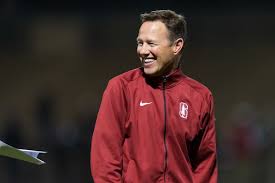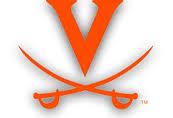In the early 1990s, the Virginia Cavaliers claimed four consecutive National Championships. Virginia, coached by Bruce Arena, amassed an astonishing 84-9-4 record across the 1991-1994 seasons, secured two regular season ACC titles and four straight ACC tournament championships.
 Arena’s Cavaliers were widely considered the best the college game produced and were noted for a sophisticated, entertaining style of play. Even the often critical Paul Gardner of Soccer America observed favorably in 1993 “A free-flowing, attacking team, with individual soccer talent visible in every position….a joy to watch.” (Woitalla 2014).
Arena’s Cavaliers were widely considered the best the college game produced and were noted for a sophisticated, entertaining style of play. Even the often critical Paul Gardner of Soccer America observed favorably in 1993 “A free-flowing, attacking team, with individual soccer talent visible in every position….a joy to watch.” (Woitalla 2014).
 Presently, another program dominates college soccer. Under the direction of head coach Jeremy Gunn, Stanford won the last three National Championships accumulating an overall record of 52-7-10. The Cardinals captured four straight Pac-12 championships and set school records in 2017 for wins (19), shutouts (16), loses (2) and fewest goals allowed (9).
Presently, another program dominates college soccer. Under the direction of head coach Jeremy Gunn, Stanford won the last three National Championships accumulating an overall record of 52-7-10. The Cardinals captured four straight Pac-12 championships and set school records in 2017 for wins (19), shutouts (16), loses (2) and fewest goals allowed (9).
While Gunn’s Cardinals are extraordinarily successful, and once again serious contenders to repeat as national champions, their style of play does not inspire the same admiration as Virginia. Unlike the 90s Virginia teams, the Cardinals are sometimes criticized for rugged play (Warshaw 2016), reliance on set-pieces (Moore-Bloom 2018), and for preferring a more direct, counter-attacking game (AP 2016).
Despite enjoying similar successes, Stanford and Virginia approached the game much differently. We thus sought a closer, statistical examination of the two programs. How do they compare across the championship years? How truly dominant was Virginia? Is Stanford of equal measure?
Season Performance Measures
Table 1 compares the teams on four performance metrics.[1] First, let’s consider season goal differential. Stanford improved differentials each championship season, achieving a high of nearly 40 goals better than its competition in 2017. Virginia improved as well yet sustained considerably higher differentials than Stanford. In fact, Virginia’s lowest differential (+48) surpassed Stanford’s highest by 9 goals. For both teams, goal differentials are outstanding, few Division 1 teams can generate these numbers for one season let alone consecutive years. Virginia however is exceptional.
Table 1. Stanford and Virginia Comparison of Season Performance Metrics
Stanford Virginia
|
Metrics |
2015 |
2016 |
2017 |
1992 |
1993 |
1994 |
|
Goal Differential |
+24 |
+28 |
+39 |
+48 |
+50 |
+51 |
|
Total Shots Ratio |
.57 |
.61 |
.63 |
.68 |
.68 |
.72 |
|
Shot Efficiency |
.12 |
.10 |
.12 |
.18 |
.14 |
.18 |
|
Opposition Shot Efficiency |
.06 |
.06 |
.04 |
.14 |
.08 |
.16 |
Source:Men’s soccer web sites for both programs.
 Virginia’s stellar attack is also evident when comparing total shot ratios. Total shots ratio (TSR) quantifies how frequently a team shoots compared to its opponents.A ratio of 0.50 indicates a team conceded as many shots as it took, and a value over .50 shows the team outshot its opponents. In addition, high TSR teams generally possess the ball more than low TSR teams (Joslyn, Joslyn, Joslyn 2017c).
Virginia’s stellar attack is also evident when comparing total shot ratios. Total shots ratio (TSR) quantifies how frequently a team shoots compared to its opponents.A ratio of 0.50 indicates a team conceded as many shots as it took, and a value over .50 shows the team outshot its opponents. In addition, high TSR teams generally possess the ball more than low TSR teams (Joslyn, Joslyn, Joslyn 2017c).
Ratios in the high 0.50s and low 0.60s are excellent. In fact across Division 1 teams, Stanford’s ratios are consistently in the top 25 percent. But Virginia was at another level. Their ratios would be in the very top percentile today (Joslyn, Joslyn, Joslyn 2017a).
Moreover Virginia converted their shots to goals with exceptional efficiency. Shot efficiency (SE) is measured by dividing goals by the number of shots taken. Though moments of individual brilliance are included, this metric generally reflects the quality of chances a team creates. The average for Division 1 hovers around 0.10: One goal for every 10 shots. On this dimension, Stanford does not exhibit special talent. Virginia does. Virginia’s efficiency once more underscores a superior attacking team.
 However, it is a defensive metric, opposition shot efficiency (OSE) that distinguishes Stanford. An opponent’s shot efficiency of 0.06 placed Stanford in the top 5 percent of Division 1 teams, and the 0.04 achieved in 2017 reflected a remarkable defensive squad. Stanford in fact held the competition to about half the efficiency level that its own attack produced – compare SE to OSE. By contrast, Virginia’s opponents enjoyed very high efficiency. For example,during the 1994 season, for every 10 shots Virginia’s competition created, they hit the back of the net 1.6 times. A curiously poor stat for a championship team.[2]
However, it is a defensive metric, opposition shot efficiency (OSE) that distinguishes Stanford. An opponent’s shot efficiency of 0.06 placed Stanford in the top 5 percent of Division 1 teams, and the 0.04 achieved in 2017 reflected a remarkable defensive squad. Stanford in fact held the competition to about half the efficiency level that its own attack produced – compare SE to OSE. By contrast, Virginia’s opponents enjoyed very high efficiency. For example,during the 1994 season, for every 10 shots Virginia’s competition created, they hit the back of the net 1.6 times. A curiously poor stat for a championship team.[2]
In sum, two exceptional programs achieved unprecedented success is distinctive ways. Virginia excelled on the attack, Stanford on defense. Virginia scored often, dominating the shots battle and converting shots to goals with extraordinary efficiency. Stanford cannot match Virginia’s attacking numbers. But Stanford depends much more on its ability to defend and counter. Stanford wins by limiting opponents’ quality chances. They may concede shots but allow precious few goals.
NCAA Tournament Performance
Table 2 presents the same metrics but for the NCAA tournament games. Virginia’s offensive prowess extends into tournament play, as does Stanford’s defensive muscle. Given the intensity of play and quality of competition, the shot efficiency for Virginia is impressive. In two out of the three years, Virginia’s excellent season shot efficiency actually increased in the tournament. Consider 1992. Virginia generated a 0.22 shot efficiency. This means that for every 5 shots Virginia generated, it scored a goal!
Table 2. Performance Metrics for NCAA Soccer Championship Tournament
Stanford Virginia
|
Metrics |
2015 |
2016 |
2017 |
1992 |
1993 |
1994 |
|
Goal Differential |
+9 |
+5 |
+7 |
+11 |
+9 |
+9 |
|
Total Shots Ratio |
.55 |
.54 |
.59 |
.69 |
.63 |
.60 |
|
Shot Efficiency |
.18 |
.09 |
.10 |
.22 |
.17 |
.16 |
|
Opposition Shot Efficiency |
.05 |
0 |
0 |
.08 |
.07 |
.06 |
Source:Men’s soccer web sites for both programs.
In addition, Virginia dramatically reduced the shot efficiency of its opponents. In their 1994 tournament run, the Cavaliers held the competition to 0.06 shot efficiency, a fantastic 0.10 improvement from the season statistic.
Not to be outdone, Stanford nearly perfected its tournament defense. Since their 2015 quarter-final against Wake Forest, Stanford has not conceded a goal. Twelve straight NCAA tournament games – a stretch of 1,214 minutes, 20 seconds (NCAA 2017). Across the ten 2016 and 2017 tournament games, Stanford’s opponents shot 105 times yet failed to score! For the same number of tournament games in 1993 and 1994, Virginia’s opposition shot 90 times and scored 6 times.
Conclusions
Playing entertaining soccer and scoring beautiful goals leaves a lasting impression. Consecutive shutout victories does not leave that same impression. How a team wins championships may thus determine its legacy. Virginia produced exceptional attacking numbers. Stanford produced an impenetrable defense. Both are outliers, but in different aspects of the game. Regardless of tactics and style, the teams executed at crucial moments and did so consistently. Our analyses shows that attacking and defending styles can achieve college soccer’s most coveted title and sustain championship form across multiple seasons.
The analyses also demonstrates that exceptional teams can improve. Virginia’s opponents’shot efficiency fell sharply during the tournament and dropped across consecutive championship years. An extraordinary attacking team turned a season long defensive liability into a strength during the post-season.
Meanwhile Stanford’s strength flourished during 3 championship runs. Stanford effectively limited its competition’s capacity to turn shots into goals in the 2015 tournament, and then completely closed the door in 2016 and 2017. It is often repeated that if the other team never scores we cannot lose. The Stanford experience certainly support this conclusion.
But can a defensive minded Stanford match Virginia’s four consecutive national championships? The Cardinals’ tournament runs included 3 overtime victories and 4 penalty shootouts. Virginia won every 92-94 tournament game in regular time.
The vagaries of chance may catch Stanford. We expect Stanford to excel defensively. But like Virginia, we think Stanford needs to improve on their weakest performance metric in order to keep the streak alive. If Stanford’s shot efficiency nears its own 2015 number, the likelihood of a four-peat increases considerably.
References
Associated Press. 2016. “Stanford soccer going for second straight NCAA title.” Mercury News. Dec. 10.https://www.mercurynews.com/2016/12/10/stanford-soccer-going-for-second-straight-ncaa-title/
Joslyn, Louis R., Nicholas J. Joslyn and Mark R. Joslyn. 2017a. “The Impact of Shots, Shots Against and Total Shots Ratio in College Soccer. College Soccer News. February. https://collegesoccernews.com/index.php/articles/1039-the-impact-of-shots-shots-against-and-total-shots-ratio-in-college-soccer-by-louis-joslyn-nicholas-joslyn-and-mark-joslyn
Joslyn, Louis R., Nicholas J. Joslyn and Mark R. Joslyn. 2017b. “Under Performance. Why Some Teams Fall Short of Expectations.” College Soccer News. December. https://collegesoccernews.com/index.php/articles/1136-under-performance-a-look-at-why-some-team-s-bounce-back-and-other-s-don-t-by-louis-nicholas-and-mark-joslyn
Joslyn, Louis R., Nicholas J. Joslyn and Mark R. Joslyn. 2017c. “What Delivers and Improved Season in Men’s College Soccer? The Relative Effects of Shots, Attacking and Scoring Efficiency on Year-to-Year Change in Season Win Percentage. The Sport Journal. June. http://thesportjournal.org/article/what-delivers-an-improved-season-in-mens-college-soccer-the-relative-effects-of-shots-attacking-and-defending-scoring-efficiency-on-year-to-year-change-in-season-win-percentage/
Moore-Bloom, Arlo. 2018. “Stanford coach Jeremy Gunn on why he’s optimistic about the unique American soccer system.” August 1. Soccer America.https://www.socceramerica.com/publications/article/79024/stanford-coach-jeremy-gunn-on-why-hes-optimistic.html
NCAA Division 1 Men’s Soccer Championships Record Book. 2017. http://fs.ncaa.org/Docs/stats/m_soccer_champs_records/2017/D1.pdf
Warshaw, Bobby. 2016. “I want to build an empire”: How Gunn made Stanford into a superpower.” FourFourTwo. December. https://www.fourfourtwo.com/us/features/jeremy-gunn-stanford-interview-profile-ncaa-college-soccer
Woitalla, Mike. 2014. “Bruce Arena’s unequaled journey through American soccer.” Soccer America Daily. https://www.socceramerica.com/publications/article/61792/bruce-arenas-unequaled-journey-through-american-s.html
[1] The NCAA does not provide team statistics for the Virginia championship years. We discovered team stats on Virginia’s men soccer web site but the 1991 championship year was not available. In addition, the statistics available are less detailed than typically provided today. We therefore used what was given for Virginia during the 1992, 1993, and 1994 championship years.
[2]Similarly, Goals against Average (GAA) highlights a distinct Stanford advantage over Virginia. Stanford’s GAA placed in the top 10 of Division 1 teams for the past three years, ranking second to Indiana in 2017. In 1994, Virginia’s GAA of 1.31 would rank it 109 in 2017.
Mark R. Joslyn can be reached at the Department of Political Science, 1541 Lilac Lane, 504 Blake Hall, University of Kansas, Lawrence, KS 66044 or by email at mjoz@ku.edu





